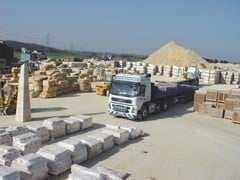Stone Supply : Stamford Stone
As a builder, Ivor Crowson knew what he wanted from stone companies and what he felt he was not getting. So he joined forces with George Wilson, who knew about stone, to establish Stamford Stone Company. More than 15 years later the company is still supplying the solutions the market wants.
With housing starts in England having fallen by 44% in 2008 and a further 22% in 2009 to hit a low of 78,000 for the year, a company established to supply housing stone might not seem to be ideally placed to ride out the economic storm.
But Stamford Stone, which was established specifically to supply the housing market with British stone, has survived the downturn practically unscathed.
It did not escape the recession entirely untouched but visit the company’s well-stocked yard at Marholm near Peterborough and you are left in no doubt about the amount of work going through the factory. Certainly there is a little less volume of tumbled walling going out than there used to be, but there is more higher value work, reflecting the kind of projects that are going ahead in Northamptonshire, Lincolnshire and Cambridgeshire where most of Stamford’s stone goes.
The change in the mix of the product from Stamford Stone happened quickly when recession hit – and being small enough to react quickly with a management team agile enough to understand that changes need to be made in response to market conditions has been vital to the Stamford Stone Company success.
When the company was set in 1996 up by successful builder Ivor Crowson and one of his suppliers, George Wilson, who ran an architectural reclamation and stone supply centre in Oundle, it was to solve a problem they had identified of getting uniformly produced walling stone that could be easily laid.
They have been aiming to solve problems ever since, and now the next generation of their families are also involved in the business. Ivor’s son, Nicholas, runs the accounts office. George’s daughter, Laura, works in the office at Marholm with her husband, Steve Green, who is the General Manager, and George’s son, Daniel, operates a tile line as a separate company, Lincolnshire Limestone Flooring.
Ivor Crowson was 49 and thinking of retiring when he and George Wilson set up Stamford Stone. It was a project he thought would be interesting. It has proved to be so. “I wouldn’t do it if it wasn’t earning, but the money isn’t the only reason I do it,” he says.
Standing in the Stamford Stone yard when NSS visited was an obelisk of Ancaster Hard White limestone, drying in the sun. It is a war memorial going into Peterborough City Centre. It will be mounted on a two-step Ancaster plinth that Stamford is also making. It was commissioned by the City Council and will be fixed by Peterborough building contractor John Lucas.
In production in the factory was radiused ashlar and dog tooth walling – some of the 200m3 of Clipsham stone being produced for contractors Szerelmey for Ripon College, Oxford.
In the masonry workshops, Alex Williams was cutting a new band of lettering for a memorial at Wing, near Milton Keynes, to replace weathered stone. He took rubbings of what remained of the original gothic lettering to create an alphabet he has used to replicate the original inscription. There are 132 letters to cut, again in Clipsham.
On other bankers, masons were producing the range of fire surrounds that Stamford have now introduced as a standard line. They are made in Ancaster, Clipsham and a new stone, Greetham limestone, that has been added to the company’s range. Standard product ranges (walling and quoins fall into the same category) can been made and put into stock, making sure the firm’s 20-plus employees, two Terzago primary saws, two 1600mm Gilberts, and two 1200mm bridge saws are kept busy. And stock is always wanted because the products are sold through all the major builders merchants in the area.
Stamford Stone Company likes to use stone that doesn’t have to travel more than 20 miles from the quarry to reach it. To help ensure that ethos, it works two quarries itself. About half of what it processes is its own stone, which it also sells as block to other masonry companies.
It extracts Clipsham from the Medwells quarry it took over from Rattee & Kett in 2003 and Greetham stone from a quarry it recently started working about seven miles north of Stamford.
Stamford Stone moved into quarrying to give itself security of supply of the stone. By the time it took over Medwells, it was buying nearly all the block Rattee & Kett was producing. Taking charge of production was seen as a rationalisation by both companies.
Moving into Greetham was another opportunity that, again, added security to the business as well as introducing an exclusive product. Greetham is similar to Ketton limestone with excellent physical properties for masonry stone and has also generated new block stone sales. Stamford Stone also operates its own fleet of lorries (again for the security of controlling this vital element of the business) both for bringing in block and taking out finished product.
There is a great diversity of products coming from Stamford Stone these days but Ivor Crowson still attributes the success of the company to the walling. By being user-friendly and less than £40/m2 it continues to attract a lot of customers. And when customers buy walling, they often also buy higher value masonry for the construction work and floors and fireplaces for interiors. n

